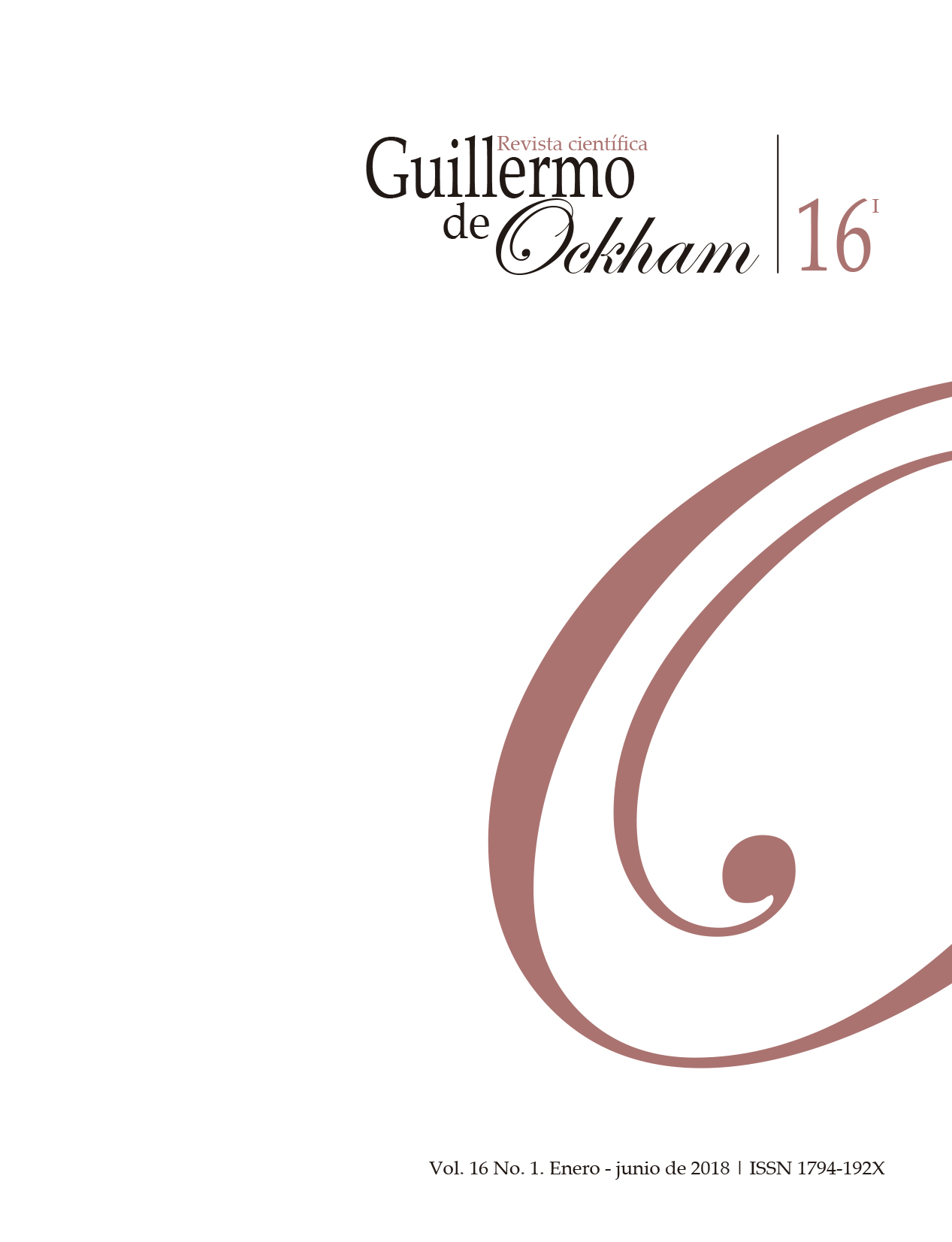La Revista Guillermo de Ockham brinda un acceso inmediato y abierto a su contenido, basado en el principio de ofrecer al público un acceso gratuito a las investigaciones para brindar un intercambio global de conocimiento. A menos que se establezca lo contrario, el contenido de esta revista tiene una licencia con Creative Commons Attribution-NonCommercial-NoDerivatives 4.0 International (CC BY-NC-ND 4.0) http://creativecommons.org/licenses/by-nc-nd/4.0/
- Atribución: debe otorgar el crédito correspondiente, proporcionar un enlace a la licencia e indicar si se realizaron cambios. Puede hacerlo de cualquier manera razonable, pero no de ninguna manera que sugiera que el licenciante lo respalda a usted o su uso.
- No comercial: no puede utilizar el material con fines comerciales.
- Sin derivados: si remezcla, transforma o construye sobre el material, no puede distribuir el material modificado.
- Sin restricciones adicionales: no puede aplicar términos legales o medidas tecnológicas que restrinjan legalmente a otros de hacer cualquier cosa que permita la licencia.
Resumen
The principal philosophical systems of India are divided into two branches: āstika and nāstika. This division, however, is basically religious, not philosophical or logical. Whatever might have been the original meanings of these two terms, so far as Indian philosophical literature is concerned, āstika means Veda-abiding and nāstika, non-Veda-abiding. This is an instance of the intrusion of Dharmaśāstra into Mokṣaśāstra: the rules of religious law operating on what was claimed to be the science of freedom (mokṣa/mukti). Thus, religious law had its position asserted and the materialists along with the Jains and the Buddhists were declared to be outside the Vedic fold.
Palabras clave:
Citas
Abu’l FaḌl. Āʿin-i Akbarī. Edited by Navalakisore, Lucknow, 1297 AH/1880 CE.
Aiyangar, Kumbakonam Viraraghava Rangaswami (ed.).(1941).Bṛhaspatismṛti (reconstructed ). Varoda: Oriental Institute.
Āryaśūra. Jātakamālā. Ed. P. L. Vaidya. Darbhanga: Mithila Institute, 1959.
AYVD Hemacandra. Anya-yoga-vyavaccheda-dātṛṃṣikā with Malliṣeṇa. Syādvādamañjarī (1933). Ed. Ānandaśaṅkara Bāpubhāī Dhruva. Poona: Bhandarkar Oriental Research Institute.
Bhaṭṭa, Yajñeśvara Cimana. (1923). Ᾱryavidyāsudhākara. Lahore: Moti Lal Banarsi Dass.
Bhattacharji, Sukumari. (1986). Literature in the Vedic Age, vol. 2. Calcutta: K. P. Bagchi.
Bhattacharya, Gopikamohan. (1961).Studies in Nyāya-Vaiśeṣika Theism. Calcutta: Sanskrit College Research Series, No. xiv. Calcutta: Sanskrit College.
Bhattacharya, Ramkrishna (2013a). Development of Materialism in India: the Pre-Cārvākas and the Cārvākas. Esercizi Filosofici 8, 2013, pp. 1-12. Link: http://www2.units.it/eserfilo/art813/bhattacharya813.pdf.
Bhattacharya, Ramkrishna (2016a). Development of Logic in India: Significance of 'The Duologue between Pāyāsi and Kassapa' ("Long Discourses"). Kriterion, Belo Horizonte, 57: 133, pp. 177-187.
Bhattacharya, Ramkrishna (2016b). Reflections on the Jābāli episode in the Vālmīki Rāmāyaṇa (Ayodhyākāṇḍa), Journal of Indian Philosophy, 44: 3, pp. 597-615.
Bhattacharya, Ramkrishna. (2009/2011). Studies on the Cārvāka/Lokāyata. Firenze: Società Editrice Fiorentina, 2009; London: Anthem Press, 2011.
Bhattacharya, Ramkrishna (2013c). Verses Attributed to Bṛhaspati in the Sarvadarśanasaṃgraha Chap. I: A Critical Appraisal, Journal of Indian Philosophy, 41:6, pp.615-30.
Brahmajālasutta. Dīghanikāya. http://buddhasutra.com/ files/brahmajala sutta.htm
BṛUp. Bṛhadāraṇyaka Upaniṣad. See EPU.
C/L. Chattopadhyaya, Debiprasad in collaboration with Mrinal Kanti Gangopadhyaya. (1990). Cārvāka/Lokāyata. New Delhi: Indian Council of Philosophical Research.
Chattopadhyaya, Debiprasad. (1964). Indian Philosophy: A Popular Introduction. New Delhi: People’s Publishing House.
ChUp Chāndogya Upaniṣad. See EPU.
Dasgupta, Surendranath. (1975). A History of Indian Philosophy. Vols. 1-5. Delhi: Motilal Banarsidass.
Datta, Roby. (1983). [Trans of the Kaṭha Upaniṣad (partial)]. Echoes from the East. Ed. Sunil Bandyopadhyay. Calcutta: Sanskrit Pustak Bhandar.
DN Dīghanikāya. Parts 1-3. Ed. Jagadish Kashyap. Patna: Pali Publication Board (Bihar Government), 1958.
EPU Eighteen Principal Upaniṣads. Eds. V. P. Limaye and R. D. Vadekar. Poona: Vaidika Samsodhana Mandala, 1958.
Frauwallner, E. (1956). Geschichte der indischen Philosophie. Band1-2. Salzburg: Otto Müller Verlag.
Gangopadhyaya, Mrinalkanti (ed. and trans.). (1982). Nyāya. Calcutta: Indian Studies, 1982.
Gangopadhyaya, M.K. (1990). Philosophy in India. Bangalore: Navakarnataka Publications.
Gerschheimer, Gerdi.(2000-2001). Religions de l’Inde: védisme et hindouisme classique. L’Annuaire de l’EPHE, pp.173-189.
Gerschheimer, Gerdi. (2007). Les ‘Six doctrines de spéculation’ (ṣaṭtarkī) – Sur la categorization variable des systems philosophiques dans l’Inde classique. In: Karin Preisendanz (ed.). Expanding and Merging Horizons (Wilhelm Halbfass Memorial Volume). Vienna: Austrian Academy of Sciences Press.
Guṇaratna. Tarkarahasyadīpikā, Commentary on Haribhadra’s Ṣaḍdarśanasamuccaya, ed. Luigi Suali. Calcutta: The Asiatic Society, 1905-14.
Halbfass, Wilhelm (1988). India and Europe: An Essay in Understanding. Albany: State University of New York Press.
Haribhadra. Ṣaḍdarśanasamuccaya. See Guṇaratna.
Haribhadra, Samarāicca Kahā . Ed. Hermann Jacobi. Calcutta: The Asiatic Society, 1926.
Hemachandra. See AYVD.
Hopkins, E. Washburn (1901/1993 ). The Great Epic of India, Delhi: Motilal Banarasidass.
Hume, Robert Ernest (trans.). (1951).The Thirteen Principal Upanishads (1921). Oxford: Oxford University Press.
Jacobi, H. (1911/1970). Zür Fruhgeschichte der indischen Philosophie. Reprinted in B. Kölver (edited by), Kleine Schriften, Teil 2, Wi¬esbaden: Franz Steiner Verlag, [1911] (first pub. in Seitzunsberichte der Königlich Preussischen Akademie der Wissenschaften, 732-743.
Jacobi, H. (1918). A Contribution towards the Early His¬tory of Indian Philosophy. Indian Antiquary, 47, pp. 101-109.
Jolly, Julius. The Minor Law Books. Delhi: MLBD, 1977 (re¬print).
Kauṭilīya Arthaśāstra. Ed. and trans. by R. P. Kangle. Parts 1-3. Bombay: University of Bombay, 1965-72.
Kane, P.V. (1968-77). History of Dharmaśāstra. Vols. 1-5 (revised ed.). Poona: Bhandarkar Oriental Research Institute.
Kaṭha Up Kaṭha Upaniṣad. See EPU.
Kṛṣṇamiśra., Prabodhacandrodaya. Edited and translated by S.K. Nambiar Delhi: MLBD, 1971.
Madhusūdana Sarasvatī. Prasthānabhedaḥ. Pune: Anandashrama, 1977.
MaiUp. See Van Buitenen.
Maṇimēkalai. See Sīthalai Sātanār.
Manu Manusmṛti with commentaries of Medhātithi and eight others. 6 vols. Ed. Jayantakrishna Harikrishna Dave. Bombay: Bharatiya Vidya Bhavan, 1972-84.
Manu’s Code of Law. Trans. Patrick Oliville, Suman Oliville. New York: Oxford University Press, 2005.
Mbh Mahābhārata, The. Critically edited by V. S. Sukthankar and others. Poona: Bhandarkar Oriental Research Institute, 1933-1966.
Mbh Mahābhārataṃ. Vulgate with Nīlakaṇṭha’s commentary, Bhāratabhāvadīpa, ed. Pancanana Tarkaratna. Kalikata: Vangavasi, 1832 Śaka /1910 CE.
Moghe, S. G. (2000). History of Dharma-Śāstra in Essence. Mumbai: MM. Dr. P. V. Kane Memorial Trust.
Nicolson, Andrew J. (2015). Unifying Hinduism. Ranikhet: Permanent Black.
NM Jayantabhaṭṭa. Nyāyamañjarī. 3 vols. Ed. G. Shastri. Varanasi: Sampurnanand Sanskrit Vishvavidyalaya, 1982-84.
NS Nyāyasūtra. Ed. by Walter Ruben. Die Nyāyasūtra’s, Abhandlungen für die kunde des Morgenlandes herausgegeben von der Deutschen Morgenländischen Gesellschaft, Leipzig, 1928.
Rāmāyaṇa of Vālmīki. 1983. Ed. Shastri Shrinivas Katti Mudholkara. Delhi: Parimal Publications. (Vulgate)
Sāyaṇa-Mādhava. Sarvadarśanasaṃgraha. Ed. V. S. Abhyankar. Poona: Bhandarkar Oriental Research Institute, 1978.
Siddharṣi. See UBhPK.
Sinha, Jadunath. (1952, 1956, 1971). History of Indian Philosophy. Vols. 1-3. Calcutta: Sinha Publishing House.
Sīthalai Sātanār. (1989). Maṇimēkalai. Trans. Prema Nandakumar. Thanjavur: Tamil University.
Squarcini, Federico. (2011). Pāṣaṇḍin, vaitaṇḍika, vedanindaka and nāstika. On criticism, dissenters and polemics and the South Asian struggle for the semiotic primacy of veridiction. Orientalia Suecana.
Tarkavagisa, Phanibhusana. (1978). Nyāya Paricaya. Kalikata: Paschimbanga Rajya Pustak Parshat.
TS Śāntarakṣita. Tattvasaṅgraha (with Pañjikā by Kamalaśīla). Ed. Dvarikdas Sastri. Varanasi: Bauddha Bharati, 1968, 1981.
UBhPK Siddharṣi. Upamiti-bhava-prapañcā-kathā. Eds. Peter Peterson and Hermann Jacobi. Calcutta: The Asiatic Society, 1901-1914.
Vālmīki Rāmāyaṇa, The. Critically edited by G.H. Bhatt and others. Baroda: Oriental Institute, 1960-75.
Van Buitenen, J. A. B. (1962). The Maitrāyaṇīya Upaniṣad. ‘S-Gravenhage (Copenhagen): Mouton.
Vasudevahiṃḍī. Saṅghadāsagaṇi Vācaka. Vasudevahiṃḍī Prathama Khaṇḍam. Ed. Caturavijaya and Punyavijaya (1930-31). Gandhinagar: Gujarat Sahitya Akademi, 1989.
Vātsyāyana. Kāmasūtra with Jayamaṅgalā, Varanasi: Chowkhambha, n.d.
Whitney, W. D. (1890).Translation of the Kaṭha-Upanishad, Transactions of the American Philological Association. Vol. 21, pp.88-112.
Winternitz, Maurice. (1985). A History of Indian Literature. Vol.3. Delhi: Motilal Banasidass (reprint).
Yājñavalkyasmṛtiḥ. Ed. V. L. Panashikar. Bombay: Nirnaya Sagar Press, 1918.






























